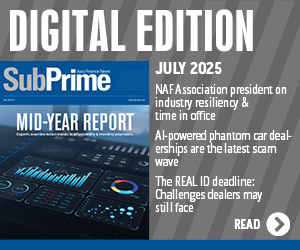ANALYSIS: Negative auto equity has doubled in 10 years

A new vehicle is one of the worst investments you can make. We’ve all heard it before: “Half the value is lost as soon as you drive it off the lot.”
The fact is, however, that vehicles today are hanging on to more of their value for longer than ever before because the quality, reliability and technology in today’s vehicles continue to improve.
J.D. Power estimates that the depreciation for a car up to 8 years old will reduce to a rate of 13.3% in 2020. This is noteworthy when you consider that in 2012 the depreciation rate was 14.2%. In a business that is as margin sensitive as the automotive sector, that is remarkable. By 2024 we expect depreciation to slow to a rate of exactly 13%.
For many American owners, the point is moot.
While depreciation rates of vehicles are slowing down, it is scant comfort for owners who moved beyond the once-standard three-year loan and taken on extended four- or five-year loan, find themselves underwater.
The past year has seen a significant increase in so-called negative equity loans in which the amount due is more than the value of the vehicle. It is a trend that has been steadily rising over the past 10 years. In 2009, only 3.2% of outstanding vehicle loans carried negative equity. In 2019, more than 8% of owners were stuck in these deals. Negative equity loans have more than doubled in that time.
As mainstream media coverage of this phenomenon has picked up, it has conjured images of exploitative institutions that are trapping consumers in a financial conundrum. However, when you look at the numbers closely, an interesting fact emerges. The biggest funders of this segment of new and used auto loans have been your friendly neighborhood credit unions.
Indeed, credit unions have doubled down on this category of auto financing. Back in 2009, only 7% of loans issued by credit unions would result in negative equity situations. In 2019, that number has more than doubled to 18%.
Will Rising Tide of Car Sales Get Swamped by Underwater Loans?
If we see another doubling of owners with negative equity, demand for new and used vehicles could be hampered. That is why the effect of rising negative equity on the industry is worth exploring. An uncertain economic outlook, a change in the price of credit for consumers, and/or the availability of credit-worthy buyers could conflate in any number of ways to soften sales in 2020 and beyond.
All stakeholders in the ecosystem will be affected.
The finance community will have to come to grips with crafting loans that pay off old vehicle debt to facilitate new purchases. The risk management issues around collateral alone are substantial.
Dealers could respond by requiring consumers to come up with higher down payments. This, however, is not likely to be an attractive option for many prospective buyers, particularly millennial and Gen Z customers. These emerging generations already have higher debt and lower savings than other demographics. To resolve the impasse, dealers may resort to reducing prices of new purchases or accepting higher valuations for trade-ins to bridge the gap between what people owe and what financial backers are willing to lend.
However it shakes out, lenders, dealers — and even OEMs — should prepare now for a growing portion of shoppers coming onto the lot carrying significant negative equity.
David Paris is a senior analyst at J.D. Power Valuation Services. With over a decade of experience in the automotive industry, David is an expert in the analysis of new and used vehicle market data. David is responsible for the creation of data-driven insights on new and used vehicle market performance and author of Guidelines, a monthly in-depth review of the automotive industry.


